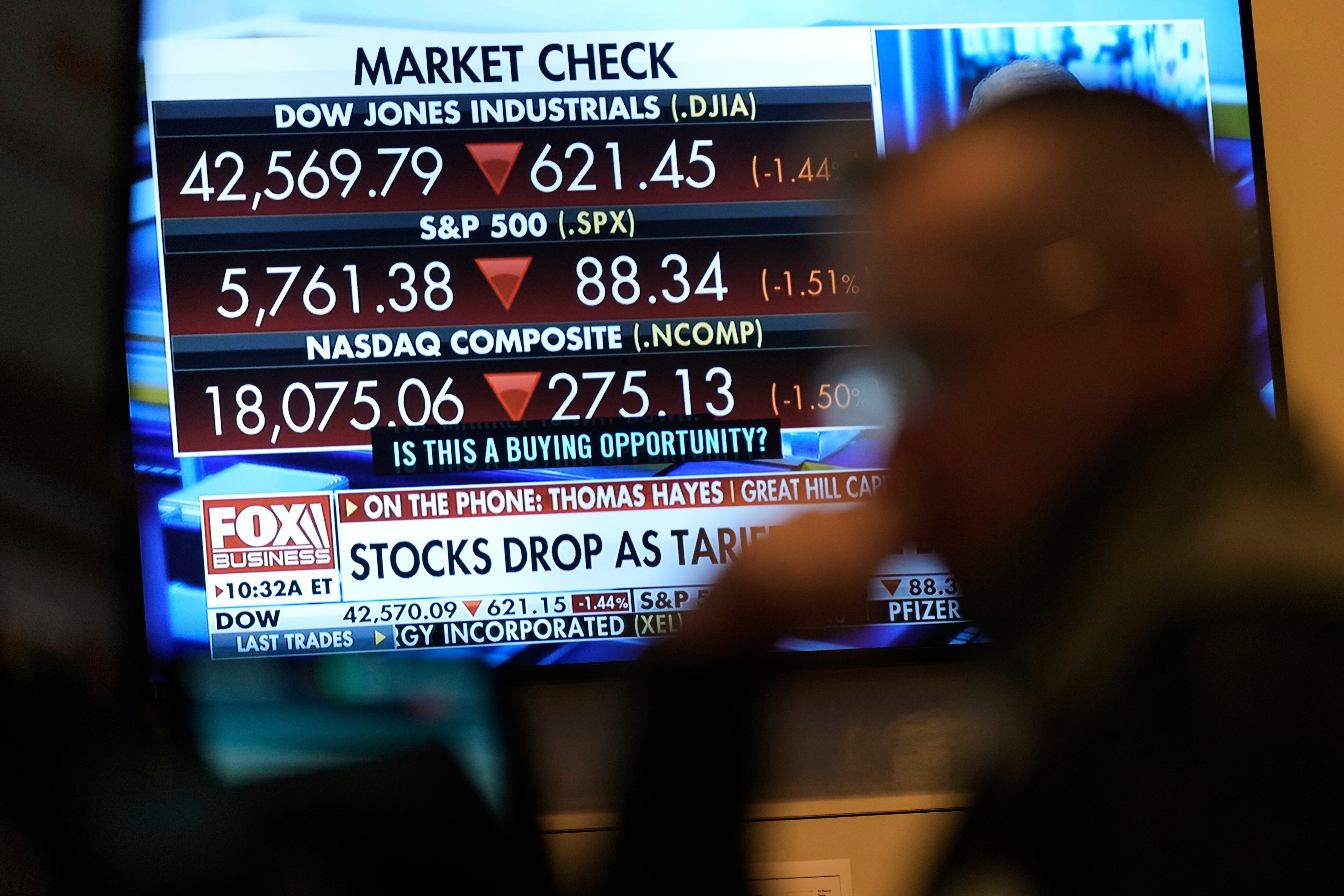NEW YORK (AP) — Another wipeout is swamping Wall Street Friday on worries about a potentially toxic mix of worsening inflation and a U.S. economy slowing because of households afraid to spend due to the global trade war.
The S&P 500 was down 2% in afternoon trading and on track for one of its worst days of the last two years. It's also heading for its fifth losing week in the last six after wiping out the last of its big gain from the start of the week.
The Dow Jones Industrial Average was down 719 points, or 1.7%, as of 2:25 p.m. Eastern time, and the Nasdaq composite was 2.6% lower.
Lululemon Athletica dropped 15.4% to lead the market lower, even though the seller of athletic apparel reported a stronger profit for the latest quarter than analysts expected. It warned that its revenue growth may slow this upcoming year, in part because “consumers are spending less due to increased concerns about inflation and the economy,” said CEO Calvin McDonald.
Oxford Industries, the company behind the Tommy Bahama and Lilly Pulitzer brands, likewise reported stronger results for the latest quarter than expected but still saw its stock fall 5.6%. CEO Tom Chubb said it saw a “deterioration in consumer sentiment that also weighed on demand” beginning in January, which accelerated into February.
They’re discouraging data points when one of the main worries hitting Wall Street is that President Donald Trump’s escalating tariffs may cause U.S. households and businesses to freeze their spending. Even if the tariffs end up being less painful than feared, all the uncertainty may filter into changed behaviors that hurt the economy.
A report on Friday morning showed all types of U.S. consumers are getting more pessimistic about their future finances. Two out of three expect unemployment to worsen in the year ahead, according to a survey by the University of Michigan. That's the highest reading since 2009, and it raises worries about a job market that's been the linchpin keeping the U.S. economy solid.
Another report released in the morning raised concerns after it showed a widely followed, underlying measure of inflation was a touch worse last month than economists expected. The data followed reports on other measures of inflation for the month, but this is the one the Federal Reserve tracks pays the most attention to as it decides what to do with interest rates.
The report also showed that an underlying measure of how much income Americans are making, which excludes government social benefits and some other items, “has been treading water for the last three months,” said Brian Jacobsen, chief economist at Annex Wealth Management.
“Households aren’t in a good place to absorb a little tariff pain,” Jacobsen said. “The Fed isn’t likely to run to the rescue either as inflation moved up more than expected in February.”
The Fed has been keeping its main interest rate on hold this year after cutting it sharply in late 2024, in part because of worries about inflation remaining above its 2% target. While more cuts to rates would give the economy and financial markets a boost, they would also push upward on inflation.
The economy and job market have so far been holding up relatively well, but if they were to weaken while inflation stays high, it would produce a worst-case scenario called “stagflation.” Policy makers in Washington have few good tools to fix it.
Some of Wall Street's sharpest losses on Friday hit companies that need customers feeling confident enough to spend, and not just on yoga wear or beach clothes. Delta Air Lines lost 5.1%. Cruise operator Royal Caribbean Group fell 4.4%. Casino operator Caesars Entertainment dropped 5.1%.
The heaviest weights on the market were Microsoft and other Big Tech stocks, whose massive sizes give their movements more sway over indexes. They and other stocks that had gotten caught up in the frenzy around artificial-intelligence technology have among the hardest hit in Wall Street's recent sell-off.
Their prices had shot up so much more quickly than their already fast-growing revenues and profits that critics said they looked too expensive. CoreWeave, whose cloud platform helps customers manage complex AI infrastructure, was bouncing between modest losses and gains in its first day of trading on the Nasdaq.
On the flip side, among the relatively few rising stocks on Wall Street were those that can make money almost regardless of what the economy does, such as utilities. American Water Works rose 2.1%, for example.
Stock markets worldwide will likely remain shaky as an April 2 deadline approaches for more tariffs. That’s what Trump has called “Liberation Day,” when he will roll out tariffs tailored to the United States’ trading partners. In each case, he said the “reciprocal” tariff will match the burden the other country places on the United States, including things like value-added taxes.
In stock markets abroad, indexes fell sharply in Japan and South Korea as auto makers felt more pressure following Trump’s announcement that he plans to impose 25% tariffs on auto imports. Hyundai Motor fell 2.6% in Seoul, while Honda Motor fell 2.6%, and Toyota Motor sank 2.8% in Tokyo.
On Wall Street, Ford Motor fell 2.2%, and General Motors sank 1.5%. Even U.S. automakers selling vehicles in the country can feel the pain of such tariffs because their supply chains are spread throughout North America. Trump says he wants more manufacturing to take place within the United States.
Thailand’s SET lost 1% after a powerful earthquake centered in Myanmar rattled the region, causing the prime minister to declare a state of emergency for the capital, Bangkok.
In the bond market, the yield on the 10-year Treasury tumbled to 4.25% from 4.38% late Thursday. It tends to fall when expectations for either U.S. economic growth or inflation are on the wane.
___
AP Writers Jiang Junzhe and Matt Ott contributed.









